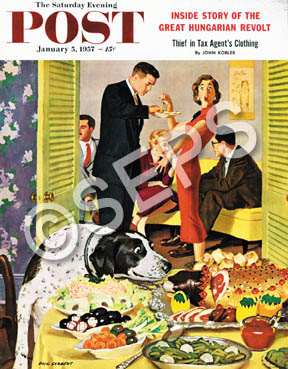RICHARD “DICK” SARGENT (1911-1978)

Doggy Buffet
1/5/1957
Richard “Dick” Sargent was a Midwesterner, born and raised in Moline, Illinois. He was raised in a close-knit family that would later provide fodder for many of his humorous vignettes. After graduating from high school, he accepted a job at the local printing plant working in the engraving department. His job entailed transferring original art onto printing plates. As Dick began to master this task, he soon realized that he had developed an interest in creating his own art. Moline had an art school that he attended by night and worked at an advertising company by day. During the next twenty years, with additional training at Washington, D.C.’s Corcoran School of Art and Phillips Memorial Gallery, he cultivated his skills and became a beloved favorite of his growing public.
Sargent spent his life traveling to distant places, but never lost touch with those simple Middle American roots. Although it was not common in this era to spotlight personal shortcomings, Dick’s covers not only entertained the masses but gave them permission to acknowledge the funny yet realistic side of life. With his discerning eye and marvelous sense of humor, he was able to capture the essence of humorous moments in our day-to-day existence.
Richard Sargent’s first cover for The Saturday Evening Post appeared in 1951 and culminated in the early sixties, having illustrated 47 popular covers. He used a framing technique in which he created a progressive story with the outcome left to the viewer’s imagination. The October 21, 1961 Post cover "Rush Hour” is a marvelous example of telling a universal story through a four-frame image. A man passes a woman walking her dog while he is rushing to catch a cab to the airport. Not minutes later the woman strolls by as the man sits stuck in rush hour traffic. The tales that Sargent was able to weave could take place in any bustling American city to any one of us. Sargent’s mantra reminded us to keep our sense of humor in tact in the face of trying situations. Having an innate love of the relational aspect of life, his multipanel approach analyzed and exposed the shifting roles between husbands and wives, parents and children, and employees and bosses. In allowing us to have a real look at ourselves from a cultural perspective, he was hoping that a deeper understanding of our motivations would emerge.
Child psychology was another area of life that intrigued him. His marriage to Helen produced a son, Anthony. Out of that union came adventure after adventure causing Sargent to conclude, “expect the unexpected”. He knew that children were complex individuals with complex natures. If we fully understood them, they would not be so fascinating. His red-headed son was a great example of this theory and Anthony’s antics appeared on many covers throughout Sargent’s tenure at the Post.
Sargent’s wife, Helen, was the inspiration for a number of significant covers, as well. “Parisian Artist and Tourist” was rendered after Mr. and Mrs. Sargent took a vacation to the city of Paris in early 1959. The female tourist and artist are trying to capture the same panorama using a different medium. This is ironic because Sargent’s style of rendering was often described as a combination of photorealism and cartooning. In the “Parisian Artist and Tourist” cover the artist looks to be a caricature of himself and the woman personifies a typical American tourist that is so busy trying to capture the scenery on fil, she forgets to pause and enjoy her surroundings. A further irony would present itself in the future when key illustrators of Sargent’s era were forced out of their profession with the advent of photography.
After struggling to find work during the mid-sixties, Sargent and his wife, Helen, moved to the Andalusia region of Spain to paint leisurely and enjoy relaxation and retirement. He died suddenly in 1978, at the age of 67, and was buried in Spain, a country he had grown to love during the last fifteen years of his life. Sargent left us with many fun memories of our growing years as a culture.
